dLocal’s Q3 2024 earnings results saw the Uruguay-based emerging markets specialist grow revenues and volumes, despite headwinds in some markets. FXC Intelligence’s Editor-in-Chief Lucy Ingham spoke to CFO Mark Ortiz to learn more about the quarter’s drivers and dLocal’s future strategy.


Payments processor dLocal has once again seen growth amid ongoing headwinds in Q3, reporting record revenues of $186m (up 13% YoY) and a record gross profit of $78m (up 5%), which drove a profit margin of 42%.
Currency devaluation, volatility and a loss in wallet share for a major Brazilian merchant created headwinds for the company in Q3. However, dLocal’s diversification strategy continues to help the company sustain its growth, with strong rises in Egypt, Mexico and other African and Asian markets helping offset revenue declines.
Total payment volumes (TPV) grew 41% to $6.5bn, with cross-border volumes rising 35% to surpass $3bn in volumes for the first time. A big driver of these was financial services and remittances, with strength in the latter vertical highlighted by 82% volume growth, as well as 58% growth in pay-outs volume.
Though the company saw its adjusted EBITDA fall 6% YoY to $52m, it noted that it continued to grow its operating leverage for a second consecutive quarter and maintained profits despite investments in staff and operations. To this end, the company has gained an international money transfer operators licence in Nigeria, a financial system auxiliary services licence in Ecuador and new payment service provider licences in Uganda.
dLocal has held fast to its full-year guidance, and the company continues to aim to answer the demand for merchants in emerging markets while also improving its resilience against volatility. The results were met with a positive response from investors, driving an increase in share price.
We caught up with CFO Mark Ortiz to identify key drivers for the quarter and discuss the company’s strategy going forward.
Drivers of dLocal’s strong TPV growth
Lucy Ingham:
Let’s start with your primary metric: flows. You reported another strong quarter in terms of TPV, with 41% growth. What are the key drivers there?
Mark Ortiz:
Quarter over quarter, we’re seeing this nice increase in our key performance indicator. This is evidence of how our merchants trust our capabilities by moving all this volume through us. TPV reaching $6.5bn – a record – along with record gross profit, is something that we’ve been very excited about.
Of the bigger drivers, there’s a couple of things going on. We’ve talked about Brazil being a bit off: we’ve had a repricing going on, we had one of the largest merchants move their volume away from us. But what we are seeing is that every country is starting to kick in with their piece, and they’re starting to participate in this wave.
We’ve seen very strong participation from the other LatAm countries – Colombia, Peru doing very well – other Asia, and in Africa, South Africa specifically doing really well. Mexico, of course one of our largest markets, is continuing to do very well.
Then we’re starting to see some other countries, too, starting to come back. Argentina is starting to come back after a weaker second half of last year and in the first half of the year.
It feels pretty good as we look at our portfolio. Diversification of growth is starting to kick in really nicely, and we’re really excited about this.
The other piece we’re starting to see is that all of our verticals were accretive this quarter. We’re seeing some strong performance in remittances and financial services, with those businesses growing 80%+, which shows the strength of the business and the relationships we have with our merchants.
dLocal maintains FY guidance as revenues and gross profits rise
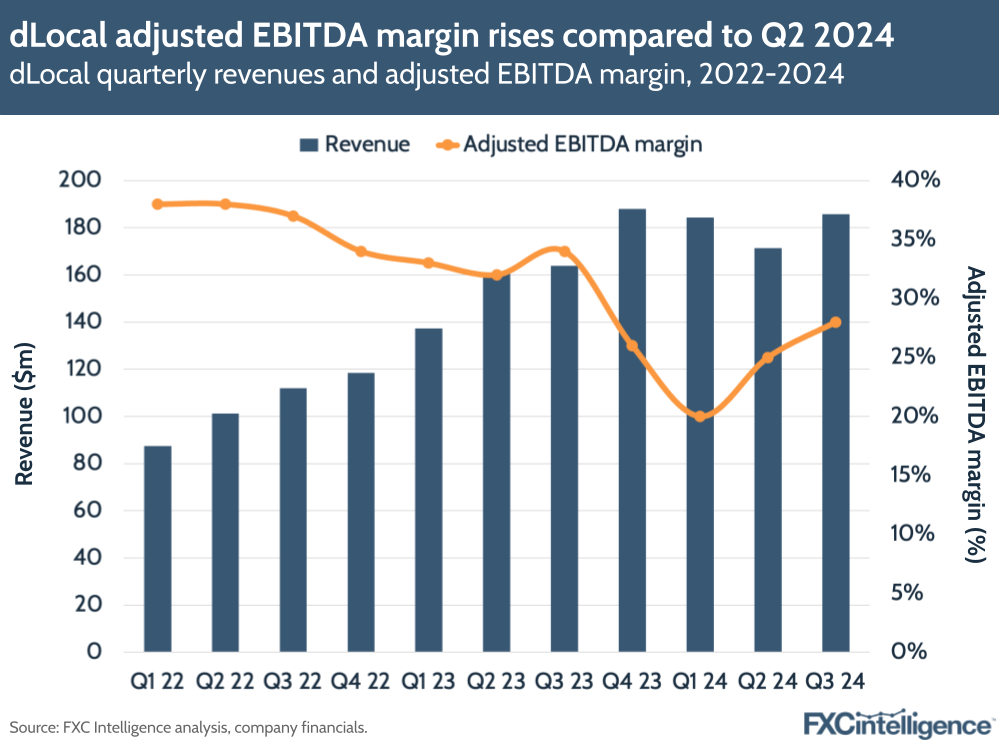
Revenue grew 13% to $186m in Q3, slower growth than the 47% in Q3 2023 but up from 6% growth last quarter. The company’s EBITDA was down 6% YoY, though it rose 23% quarter-on-quarter to $52m, giving a margin of 28%. This is down six percentage points from last year, but up three points compared to Q2 2024.
Though not giving revenue guidance, the company said that it was maintaining its TPV guidance at $24.5bn-26.5bn, with a gross profit of $280m-300m and adjusted EBITDA of $180m-200m, with the addendum that its Q4 results are heavily weighted to the next 3-4 weeks, when the company expects a seasonal uplift in commerce volumes from Black Friday.
Despite some headwinds across key geographies during the quarter, gross profit grew 5% YoY to $78m, giving a gross profit margin of 42% (down from 45% last year). Net income was also down 34% compared to Q3 2024, though the company noted it had seen a stable net take rate of 1.2%.
The company did note that if applying constant currency across its main markets of Brazil, Mexico, Argentina, Egypt and Nigeria, gross profit would have been 6% higher during Q3 2024.
Cross-border’s role in dLocal’s ongoing strategy
Lucy Ingham:
Cross-border volumes are a lower share of your overall TPV than they were a year ago but were at record levels this quarter, and many of your newer markets are cross-border. What role do you see cross-border playing in dLocal’s strategy now and in the future?
Mark Ortiz:
For cross-border we broke the $3bn mark this quarter, so that was a nice feat for us.
Cross-border really is our sweet spot: that’s where it’s our higher take rate. We believe that that’s the bread and butter of our business, and it’s continuing to grow nicely.
What we’re seeing is [markets where cross-border is a higher share], including Mexico, but other LatAm, other Africa and Asia, those countries, are starting to pick up quite a bit of volume.
We’re starting to see a lot of the merchants that we are working with developing those businesses for us in those countries. And I believe, based on what I’ve seen, that it’s going to continue to be a strong part of our offering going forward.
Cross-border volumes surpass $3bn in Q3 2024
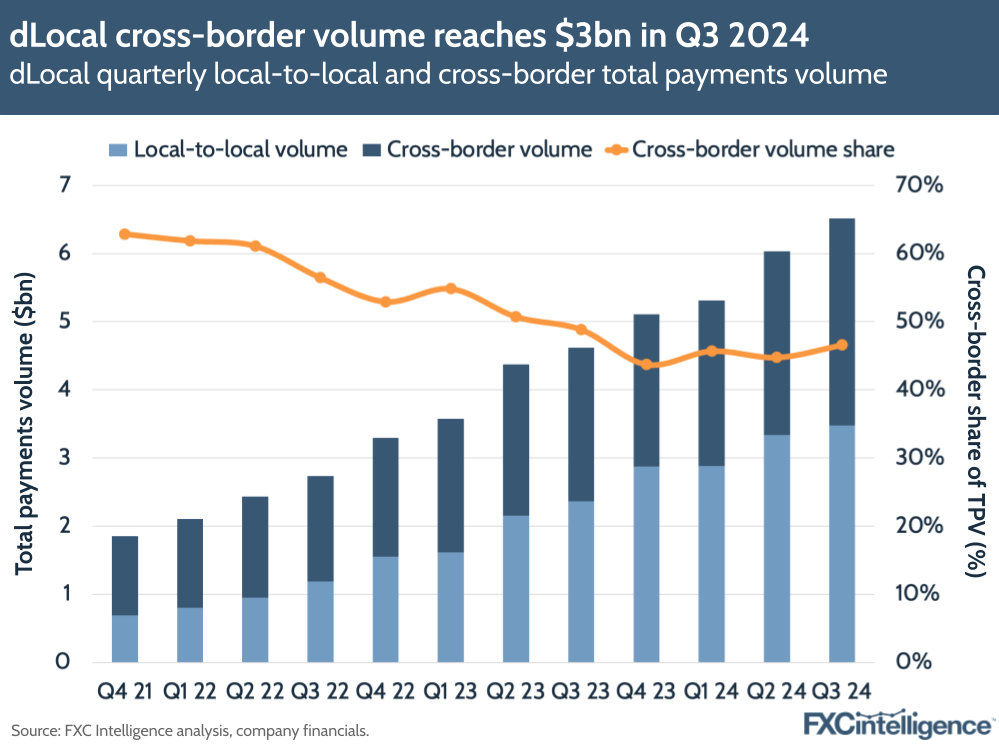
Cross-border volumes grew by 35% in Q3 2024 to surpass $3bn for the first time. While accounting for 47% of TPV, this was down from 49% in Q3 2023 and 56% in Q3 2022, though this share has grown from 46% in Q1 and 45% in Q2 of this year. The share has declined as cross-border continues to be outpaced by growth in local-to-local payments, which rose by 47% in Q3 to $3.5bn.
Having said this, the gap between the rate of growth in cross-border volumes, TPV and local-to-local volumes has closed over time. dLocal has been spurred by its diversification into new markets, and with CEO Pedro Arnt saying during the call that many of the newer markets being added by the company have been cross-border, it will be interesting to see whether this changes moving forward.
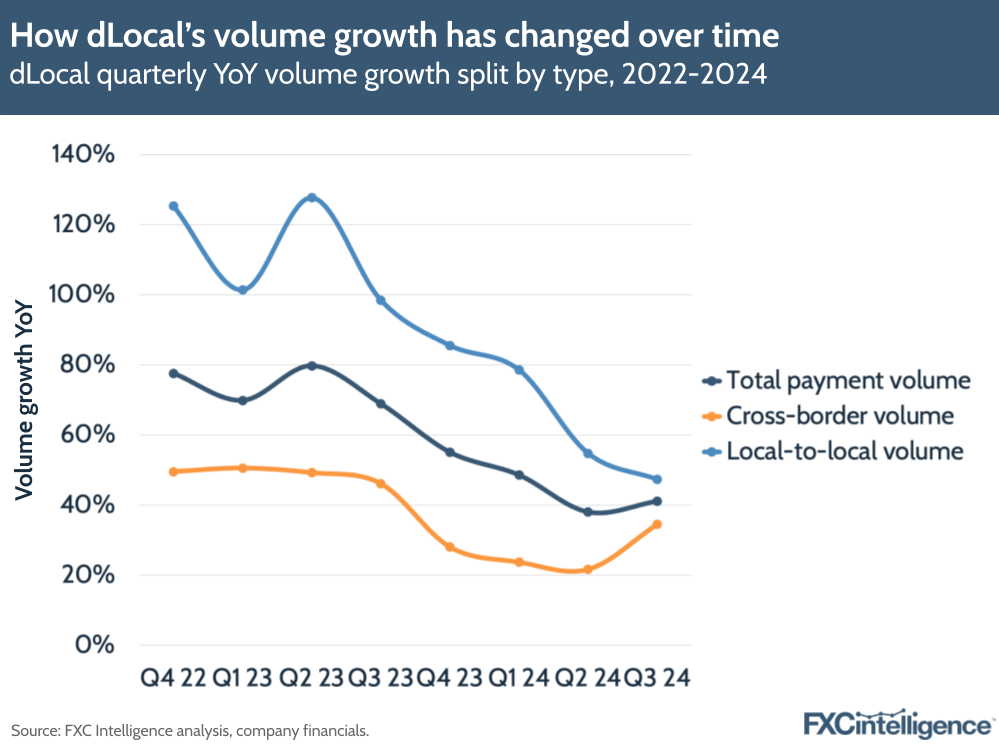
Meanwhile, local-to-local TPV grew with strong performance in Mexico and Argentina, but the company did note a sequential growth slowdown driven by a loss of wallet share in credit card payments with a top commerce merchant.
Remittances’ impact on growth
Lucy Ingham:
Your remittances vertical remains small compared to some of your bigger segments, but led on TPV growth, at 82% YoY. How are you thinking about remittances?
Mark Ortiz:
Remittances has some really nice synergies with the rest of our business. We build the rails for the pay-outs business. We still see it growing quite nicely for us, where we’re developing some really good relationships across the board here.
Where the laws allow us, we have this model where we can net things out between pay-outs and pay-ins, and remittances is a big portion of that. We’re able to provide some really competitive rates to our merchants while maintaining a decent margin for ourselves.
It feels like a win-win situation for everybody. Remittances is something that we think will continue to be a decent part of our offering going forward.
Lucy Ingham:
How about your second biggest growth driver, financial services?
Mark Ortiz:
Financial services is similar to remittances. We’ve been in the business for a while and we continue to harvest the merchants that we have, continue to penetrate the merchants that we have in this vertical, increasing our share of wallet.
I feel really good about the prospect of that vertical to continue to grow at a nice clip here over the next few quarters.
dLocal sees significant growth in key verticals
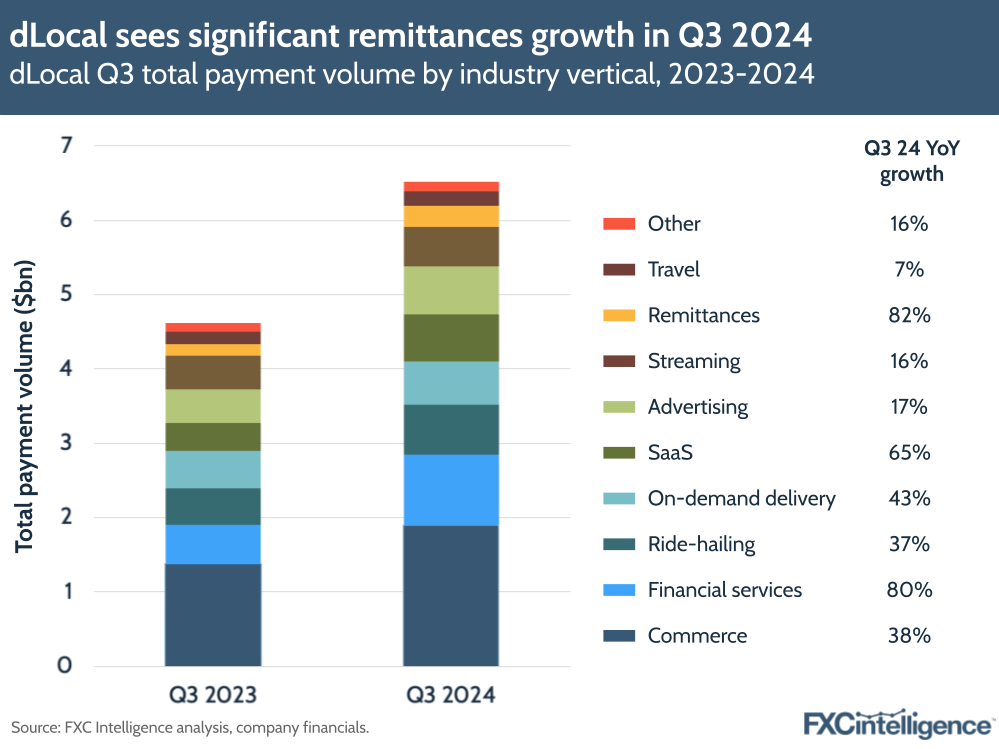
dLocal continued to see solid payment growth, with TPV rising 41% YoY and 8% on a quarterly basis to $6.5bn, though growth remains slower than last year (Q3 2023 saw 69% TPV growth).
Commerce was the company’s biggest vertical once again, rising by 38%, though the fastest growth across all the verticals was seen in remittances, which matched growth in Q2 2024 at 82% and is becoming a more significant part of volumes overall.
dLocal executives also attributed some verticals’ success to the company’s record cross-border TPV, namely commerce, financial services, on-demand delivery and software-as-a-service (SaaS). Financial services was up 80% – ramping up from a 33% rise in Q2 and 12% in Q1 – while SaaS grew 65% and on-demand delivery rose 43%.
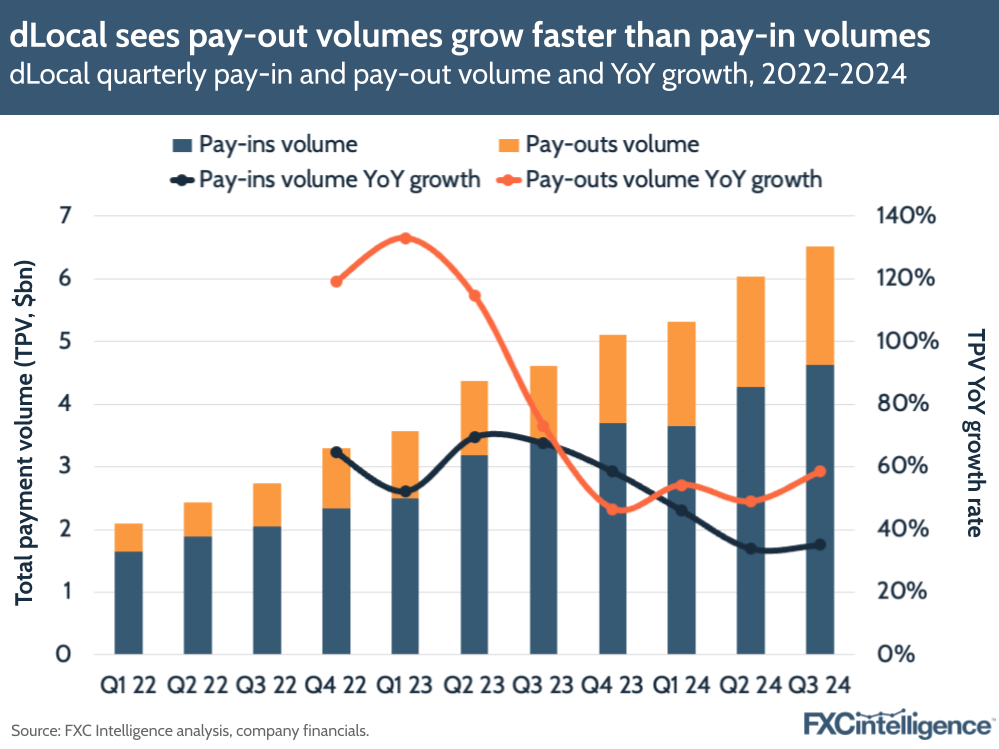
Pay-ins continued to account for the majority of dLocal’s volumes in Q3 2024 at 71% ($4.6bn), versus 29% for pay-outs ($1.9bn). However, pay-ins volume increased 35% year-over-year, while pay-outs increased by 58%, continuing a trend of pay-outs growing at a faster rate and taking a higher share of volumes.
The company noted that its pay-ins business was driven by strong performance in Mexico, Colombia, Argentina, South Africa and Egypt, while payouts was driven by financial services and remittances.
Characteristics of dLocal’s high-opportunity markets
Lucy Ingham:
Several geographies proved particularly impactful for you this quarter, including Egypt and South Africa, which are both newer geographies for you. What characterises these high-opportunity markets and how are you maximising your impact there?
Mark Ortiz:
In some places like Mexico, Brazil – the more established locations – we have a more natural business. In places like Egypt, I would consider those a bit more opportunistic.
As you know, where there’s a parallel market, there is a significant spread between the official and parallel markets, which allows us to provide liquidity to our merchants that they otherwise wouldn’t be able to access.
Egypt is a good example of a place where we’re able to take advantage of the way that the market’s playing out. Our merchants want to be there. We’re able to provide that liquidity.
Whether that lasts or not, we’ll see, and if there’s a devaluation that comes up, those revenues and margins may come down. We’re going to be seeing some of those opportunities come and go.
We will go where our merchants need us to go. We’ll also take a look at the opportunities that come along. That’s part of the play in being in these more volatile countries: you get to see some of these spikes and lows coming through.
But I believe we’re in a good place. We’re diversifying our portfolio so we’re able to manage these volatile situations a bit better, and at the same time take advantage of the situations where we can, in order to grow our revenue base.
Strong growth in Egypt, South Africa and Mexico offsets declines
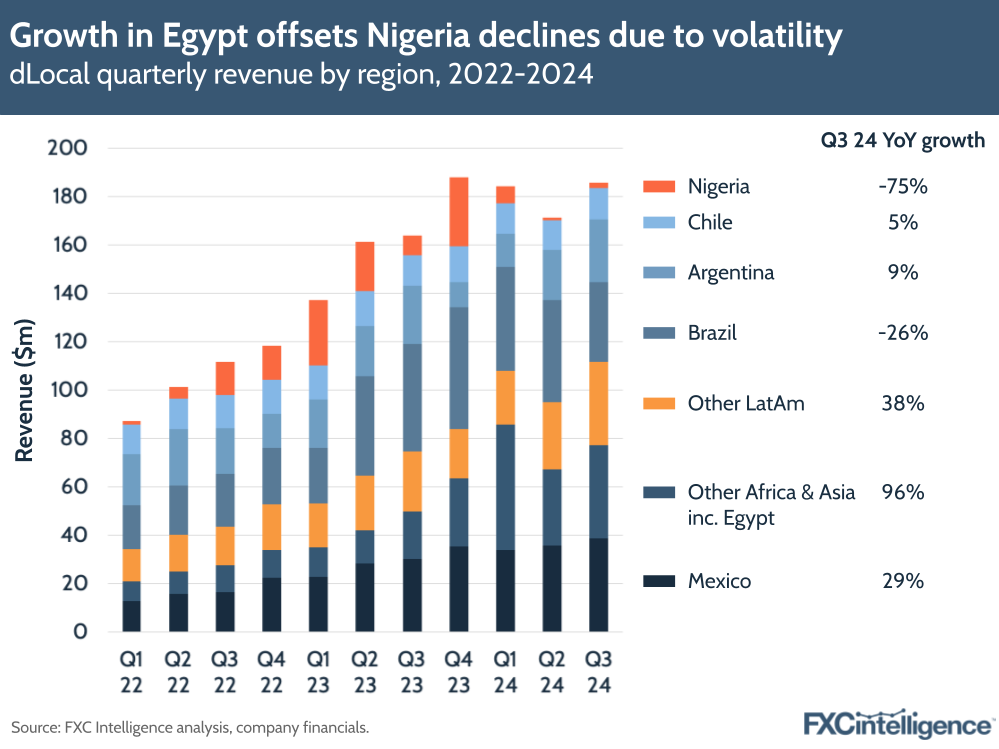
Breaking down dLocal’s geographies, the company still saw revenue headwinds across some markets, specifically Nigeria and Brazil, but this was offset by strong growth overall in several African and Asian countries, highlighting the importance of dLocal’s diversification into new geographies.
Overall, revenues for LatAm – dLocal’s core region – rose 7% to $145m (78% of total revenues, down from 83% last year), while Africa and Asia rose 45% to $41m (or 22% of revenue, up from 17% last year). Gross profit fell 6% to $56m for LatAm, but grew nearly 50% for Africa and Asia on the back of TPV growth in Egypt and a ramp up of merchants in South Africa.
Revenue from Brazil – which is central to dLocal’s LatAm segment – declined by -26% YoY as a result of aforementioned share losses on credit card payments for a major merchant client. As a result, Mexico accounted for the highest share of LatAm revenues in Q3, having grown 29%. Despite currency devaluation in Argentina driving lower gross profits for the region, it delivered 9% revenue growth, with Chile delivering 5% growth and Other LatAm markets revenue growing by 38%.
Nigeria revenue declined again, by 75%, and it accounted for just 5% of Africa & Asia revenue overall (versus 30% last year) as the country continues to see a slump in the value of the naira. Revenues in the wider Africa region were driven by strong performance in Egypt, which saw 84% revenue growth, while the company’s Other Africa and Asia segment grew 112% during the quarter.
dLocal’s record profit and approach to profitability
Lucy Ingham:
You reported record gross profit this quarter despite also continuing to grow your team globally. What has enabled that profit record, and how much has profitability been and will continue to be a priority for dLocal?
Mark Ortiz:
I know we used to talk about revenues. Now we want to focus more on gross profit. It’s a better measure of profitability and the way we look at our business.
We had record levels of gross profit this quarter, and I want to bring a couple of things in here.
Diversification: we had Brazil coming down, but everybody else picking up some of the slack. We’ve got Mexico that came in extremely strong. We had Other LatAm coming in strong, and in Asia and Africa we had Egypt again increasing quarter-over-quarter, year-over-year. Then Other Africa and Asia, specifically South Africa, coming in strong.
What I see is that diversification is working really well for us. Extending the share of wallet on some existing merchants is another area that’s worked out very well. We are seeing that come through really nicely, and that’s allowing us to perform here on the gross profit line.
The last piece here is with the growth of our business, we’re starting to be able to leverage our purchasing power a bit and get better deals in terms of our costs from an operational perspective. We’ve been able to reduce some of our transactional costs on our side in some of the bigger countries.
The loss of some of the pricing that we were experiencing in the first half of the year is starting to be offset by cost reductions in some of the negotiations that we’ve had with some of our largest providers.
Lucy Ingham:
Do you anticipate that continuing in the future? Is there more room for that to continue to evolve?
Mark Ortiz:
I think you will see both dynamics going. As we extend the share of wallet of some of our existing global merchants, they’ll move on to some higher tiers, which then will put some pressure on our pricing, so our top line.
At the same time, I believe that we’ll be able to offset some of that, and hopefully most of that, through better deals with our processors.
We’ve seen our margins stabilise here over the last couple of quarters, which is a very good sign. The plan here is to try to offset as much of the pricing pressure, as our merchants get bigger, broader, and the competition heats up here, with better cost negotiations on our side. That’s the balance that we’ll continue to work through.
dLocal employees pass 1,000 in Q3 2024
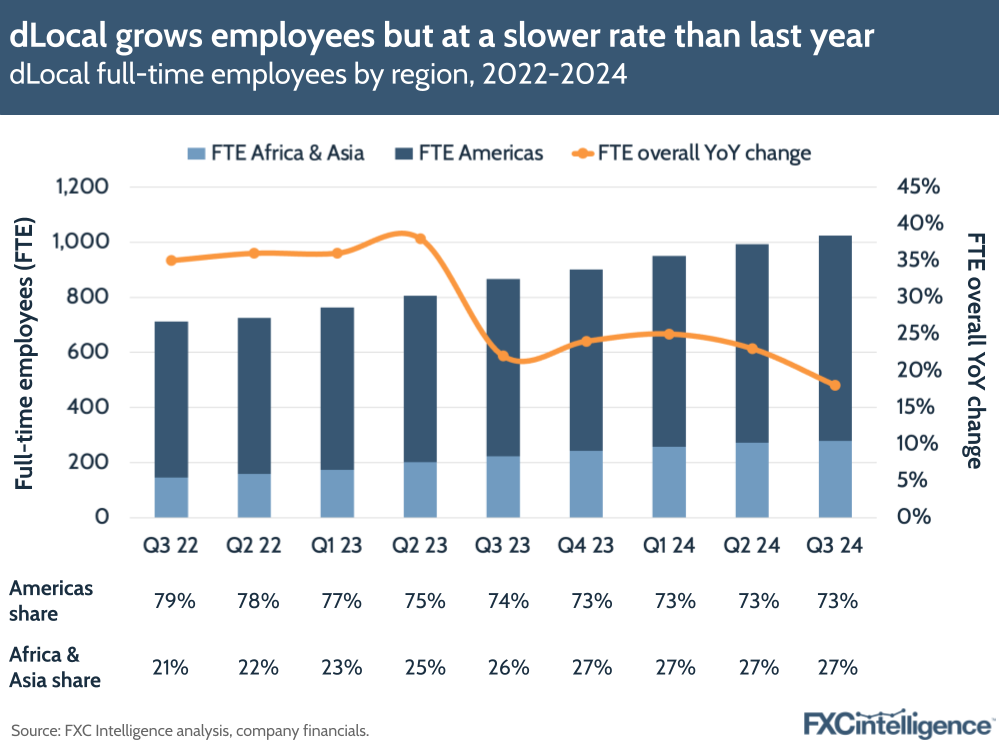
dLocal grew its employee base by 18% in Q3 2024 to surpass 1,000 employees for the first time, with 16% growth in full-time equivalents (FTEs) in the Americas region to 745, and 25% growth in FTEs in Africa and Asia to 279. Of these, the highest share of employees was in technology and product (41%), followed by operations (24%), corporate central functions (18%) and sales and marketing (17%).
However, the company has slowed hiring across its total number of employees compared to Q3 2023 (22%) and Q3 2022 (35%).
Explaining the emerging market opportunity to investors
Lucy Ingham:
The volatility of emerging markets can make telling the story of companies such as yourself to investors challenging, but your latest earnings have been met with a very positive market response. Your strong performance has obviously played a role in this, but is there anything else that you attribute this to?
Mark Ortiz:
There’s a humongous need out there for the services that dLocal provides in the Southern Hemisphere, including Africa, Asia and Latin America.
Merchants want to be part of the growth that’s happening in the Southern Hemisphere, and I think we are one of the players well suited to help them in that perspective. Our ability to go with the merchants, to put the merchants at the core of our strategy, is critical to make this work.
We bested the art of the possible, I want to say here, in terms of working with our merchants closely in terms of what they need, where their needs are. Being able to provide those types of services is important.
Along with that, it’s the diversification that I talked about: extending our share of wallet, the operational leverage that we’re starting to see. We are investing in our people and our technology, and we’re starting to see the benefits of some of that come through.
All of those things are starting to drive where our business is and where it’s headed.
Lucy Ingham:
Is there anything else you would like to mention that I haven’t covered?
Mark Ortiz:
This business has done a tremendous job working through some adversity over the last couple of years and has come out really strong on the other side, and our merchants have come along with us.
The fact that we’re at $6.5bn of TPV is evidence of that. The fact that we’re having record gross profit levels is evidence of that.
The people that we have, the passion for what we want to do here, is starting to show in the numbers that we are presenting to the Street here.
We feel really good about how we’re progressing. We’re going to continue to put the merchant at the core of all of what we do. I believe that strategy, along with the diversification of how we do things and pushing ourselves to do the art of the possible, will get us to a really nice place in the future.
Lucy Ingham:
Mark, thank you.
Mark Ortiz:
Thank you.
The information provided in this report is for informational purposes only, and does not constitute an offer or solicitation to sell shares or securities. None of the information presented is intended to form the basis for any investment decision, and no specific recommendations are intended. Accordingly, this work and its contents do not constitute investment advice or counsel or solicitation for investment in any security. This report and its contents should not form the basis of, or be relied on in any connection with, any contract or commitment whatsoever. FXC Group Inc. and subsidiaries including FXC Intelligence Ltd expressly disclaims any and all responsibility for any direct or consequential loss or damage of any kind whatsoever arising directly or indirectly from: (i) reliance on any information contained in this report, (ii) any error, omission or inaccuracy in any such information or (iii) any action resulting there from. This report and the data included in this report may not be used for any commercial purpose, used for comparisons by any business in the money transfer or payments space or distributed or sold to any other third parties without the expressed written permission or license granted directly by FXC Intelligence Ltd.



